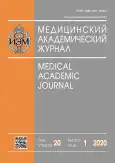Эффект внутриопухолевого имплантирования гексаферрита бария, магнетита, гематита, окиси алюминия и кремнезема на динамику роста опухоли Эрлиха и выживаемость мышей-опухоленосителей
- Авторы: Вершинина С.Ф.1, Евтушенко В.И.1
-
Учреждения:
- Федеральное государственное бюджетное учреждение «Российский научный центр радиологии и хирургических технологий имени академика А.М. Гранова» Министерства здравоохранения Российской Федерации
- Выпуск: Том 20, № 1 (2020)
- Страницы: 75-82
- Раздел: Оригинальные исследования
- URL: https://bakhtiniada.ru/MAJ/article/view/34107
- DOI: https://doi.org/10.17816/MAJ34107
- ID: 34107
Цитировать
Полный текст
Аннотация
Введение. Ранее нами был показан противоопухолевый эффект имплантата гексаферрита бария (BaO · 6Fe2O3) на модели двух внутримышечно перевиваемых солидных опухолей мышей — ЛИО-1 и Эрлиха (объем опухолей — 2 см3). В данной работе на модели солидной опухоли Эрлиха достаточно большого размера (3 см3) изучен сравнительный противоопухолевый эффект после имплантации частиц гексаферрита бария с остаточным магнитным полем около 150 мГс относительно частиц оксидов железа с остаточным магнитным полем, близким к нулю, — гематита (Fe2O3) и магнетита (Fe3O4), а также в качестве контроля — окиси алюминия (Al2O3) и кремнезема (nSiO2 ∙ mH2O).
Материал и методы. Эксперименты проведены на 70 белых мышах-самках массой 23–24 г. Злокачественную эпителиальную опухоль Эрлиха перевивали внутримышечно в правую заднюю конечность. Когда опухоль достигла размера 3 см3, мышей разделили на шесть групп в зависимости от имплантированного вещества — гексаферрит бария, магнетит, гематит, окись алюминия, кремнезем или изотонический раствор натрия хлорида.
Результаты. Обнаружено, что гексаферрит бария, имплантируемый в опухоль больших размеров (3 см3), оказывает умеренный противоопухолевый эффект на всех сроках исследования. Частицы окислов железа — магнетита и гематита — с магнитным полем, близким к нулю, не обладали противоопухолевым эффектом. К концу опыта (29-й день) во всех группах, в том числе в контрольной, наблюдалась гибель от 20 до 50 % животных, а опухоли были в существенной мере некротизированы. Исключение составила группа с имплантацией в опухоль кремнезема, в которой выжили все мыши, а сами опухоли не содержали некрозов и имели равномерную розовую окраску.
Ключевые слова
Полный текст
Открыть статью на сайте журналаОб авторах
София Фатхутдиновна Вершинина
Федеральное государственное бюджетное учреждение «Российский научный центр радиологии и хирургических технологий имени академика А.М. Гранова» Министерства здравоохранения Российской Федерации
Автор, ответственный за переписку.
Email: sofia.vershinina2010@mail.ru
ORCID iD: 0000-0002-8751-9168
SPIN-код: 5864-5627
д-р биол. наук, ведущий научный сотрудник
Россия, Санкт-ПетербургВладимир Иванович Евтушенко
Федеральное государственное бюджетное учреждение «Российский научный центр радиологии и хирургических технологий имени академика А.М. Гранова» Министерства здравоохранения Российской Федерации
Email: sofia.vershinina2010@mail.ru
ORCID iD: 0000-0002-1577-4178
SPIN-код: 6167-0141
д-р биол. наук, главный научный сотрудник
Россия, Санкт-ПетербургСписок литературы
- Заридзе Д.Г., Каприн А.Д., Стилиди И.С. Динамика заболеваемости злокачественными новообразованиями и смертности от них в России // Вопросы онкологии. – 2018. – Т. 64. – № 5. – С. 578–591. [Zaridze DG, Kaprin AD, Stilidi IS. Dynamics of morbidity and mortality from malignant tumors in Russia. Vopr Onkol. 2018;64(5):578-591. (In Russ.)]
- Каприн А.Д., Старинский В.В., Петрова Г.В. Злокачественные новообразования в России в 2016 году (заболеваемость и смертность). – М.: МНИОИ им. П.А. Герцена, 2018. – 250 с. [Kaprin AD, Starinskiy VV, Petrova GV. Zlokachestvennye novoobrazovaniya v Rossii v 2016 godu (zabolevaemost’ i smertnost’). Moscow: MNIOI im. P.A. Gertsena; 2018. 250 p. (In Russ.)]
- Гершанович М.Л., Филов В.А., Акимов М.А., Акимов А.А. Введение в фармакотерапию злокачественных опухолей. – СПб.: СОТИС, 1999. – 152 с. [Gershanovich ML, Filov VA, Akimov MA, Akimov AA. Vvedenie v farmakoterapiyu zlokachestvennykh opukholey. Saint Petersburg: SOTIS; 1999. 152 p. (In Russ.)]
- Евтушенко В.И., Вершинина С.Ф., Гранов А.М. Подавление роста и метастазирования злокачественных новообразований с помощью внутриопухолевой имплантации гексаферрита бария // Сибирский онкологический журнал. – 2009. – № S2. – С. 68. [Evtushenko VI, Vershinina SF, Granov AM. Podavlenie rosta i metastazirovaniya zlokachestvennykh novoobrazovaniy s pomoshch’yu vnutriopukholevoy implantatsii geksaferrita bariya. Sibirskii onkologicheskii zhurnal. 2009;(S2):68. (In Russ.)]
- Гранов А.М., Вершинина С.Ф., Маркочев А.Б., и др. Оценка противоопухолевого эффекта ферромагнитного имплантата в эксперименте // Медицинский академический журнал. – 2011. – Т. 11. – № 4. – С. 51–57. [Granov AM, Vershinina SF, Markochev AB, et al. Evaluation of antitumoral effect of ferromagnetic implant in the experiment. Med Akad Z. 2011;11(4):51-57. (In Russ.)]
- Гранов А.М., Карелин М.И., Гранов Д.А., и др. Магнитожесткий ферромагнетик в экспериментальной онкологии и клинике / под ред. А.М. Гранова. – СПб.: Фолиант, 2015. – 120 с. [Granov AM, Karelin MI, Granov DA, et al. Magnitozhestkiy ferromagnetik v eksperimental‘noy onkologii i klinike. Ed. by A.M. Granov. Saint Petersburg: Foliant; 2015. 120 p. (In Russ.)]
- Гранов А.М., Вершинина С.Ф., Самсонов Р.Б., и др. Противоопухолевый эффект имплантирования гексаферрита бария мышам SHR с односторонней и билатеральной лимфосаркомой ЛИО-1 // Медицинский академический журнал. – 2017. – Т. 17. – № 1. – С. 82–87. [Granov AM, Vershinina SF, Samsonov RB, et al. Antineoplastic effect of implantation of barium hexaferrite to shr mice suffering with unilateral and bilateral lymphosarcoma LIO-1. Med Akad Z. 2017;17(1):82-87. (In Russ.)]
- Kim JS, Yoon TJ, Yu KN, et al. Toxicity and tissue distribution of magnetic nanoparticles in mice. Toxicol Sci. 2006;89(1):338-347. https://doi.org/10.1093/toxsci/kfj027.
- Вершинина С.Ф., Стуков А.Н. Экспериментальные опухоли: практическое руководство. – СПб.: Галаника, 2018. – 68 с. [Vershinina SF, Stukov AN. Eksperimental’nye opukholi. Prakticheskoe rukovodstvo. Saint Petersburg: Galanika; 2018. 68 p. (In Russ.)]
- Стуков А.Н., Иванова М.А., Никитин А.К., и др. Индекс роста опухоли как интегральный критерий эффективности противоопухолевой терапии в эксперименте // Вопросы онкологии. – 2001. – Т. 47. – № 5. – С. 616–618. [Stukov AN, Ivanova MA, Nikitin AK, et al. Indeks rosta opukholi kak integral’nyy kriteriy effektivnosti protivoopukholevoy terapii v eksperimente. Vopr Onkol. 2001;47(5):616-618. (In Russ.)]
Дополнительные файлы










